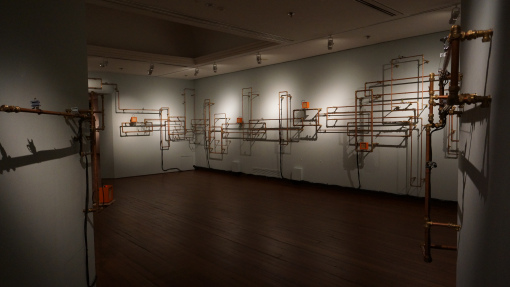Janet Cardiff and George Bures Miller – The Murder of Crows (2011)
http://https://www.youtube.com/watch?v=CKBxLX7bZZQ&playnext=1&list=PLB18283A72AAE82FC&feature=results_main
The Murder of Crows is a large installation that houses 98 audio seakers mounted around the space on stands, chairs and the wall. The structure of the piece aims to mirror the illogical but connected juxtapositions that we experience in the dream world. One soundscape moves into another with an electronic dreamscape composition shifting into sound effects such as factory noises, crashing waves into a guitar and strings composition and then into a marching band.
I thought the beauty of the this work lies it in its ability to transcend different landscapes solely based on sound as the space itself is bared to its basic. The simplicity of the installation space forces the audience to focus on the sounds produced by the speakers as they weave through the rows of chairs. It also gives sufficient space for the audience to project their own emotions and visual imagination to the sounds produced in the installation.
John Cage 4’33
John Cage 4’33 might be a cliche pick as an exemplar of sound art but having done a little more research on this work has allowed me to shed some light on Cage’s concept.
What helped sparked my understanding is realising how John Cage wishes to bring the background noises produced by the audience to the foreground. The fact that sounds produced had a system of what was foreground and background was what intrigued me. Furthermore, the greater irony is in Cage’s conformation to the established conventions of music making (music score, 3 acts). The juxtaposition of his behavior as an artist opposed to the piece created heightened the absence of “music” in his performance. Hence, it highlighted how the myriad of noises from the environment filled up the space which came in the form of time (duration) as a shared element between silence and noise.

